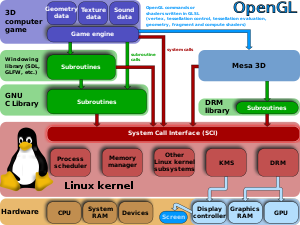OpenGL 1
 |
|

Video games outsource real-time rendering calculations to the GPU over OpenGL. The rendered results are not sent back to main memory, but to the framebuffer of video memory instead. The display controller will then send this data to the display device.
|
|
| Original author(s) | Silicon Graphics |
|---|---|
| Developer(s) |
Khronos Group (formerly ARB) |
| Initial release | January 1992 |
| Stable release |
4.5 / August 11, 2014
|
| Written in | C |
| Type | 3D graphics API |
| License |
|
| Website | opengl |
Open Graphics Library (OpenGL) is a cross-language, cross-platform application programming interface (API) for rendering 2D and 3D vector graphics. The API is typically used to interact with a graphics processing unit (GPU), to achieve hardware-accelerated rendering.
Silicon Graphics Inc., (SGI) started developing OpenGL in 1991 and released it in January 1992; applications use it extensively in the fields of computer-aided design (CAD), virtual reality, scientific visualization, information visualization, flight simulation, and video games. OpenGL is managed by the non-profit technology consortium Khronos Group.
The OpenGL specification describes an abstract API for drawing 2D and 3D graphics. Although it is possible for the API to be implemented entirely in software, it is designed to be implemented mostly or entirely in hardware.
The API is defined as a set of functions which may be called by the client program, alongside a set of named integer constants (for example, the constant GL_TEXTURE_2D, which corresponds to the decimal number 3553). Although the function definitions are superficially similar to those of the programming language C, they are language-independent. As such, OpenGL has many language bindings, some of the most noteworthy being the JavaScript binding WebGL (API, based on OpenGL ES 2.0, for 3D rendering from within a web browser); the C bindings WGL, GLX and CGL; the C binding provided by iOS; and the Java and C bindings provided by Android.
...
Wikipedia
